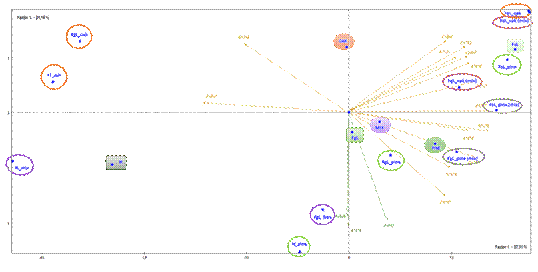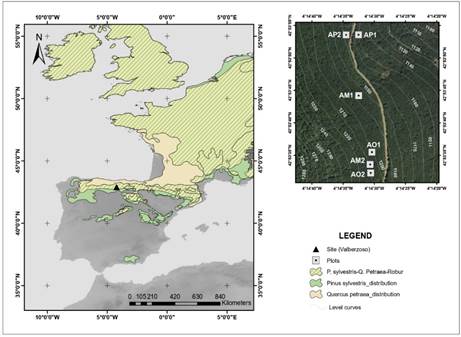INTRODUCTION
Within the framework of a global climate crisis soils constitute a valuable tool to combat climate change due to its great potential for C sequestration. Soils store two-thirds of the total carbon in terrestrial ecosystems and contain more C than vegetation and the atmosphere combined. Therefore, changes in the loss-gain dynamics of soil organic carbon (SOC) can lead to large changes in the carbon balance at a regional scale (Schlesinger & Andrews, 2000).
Apart from the role of soils, it is also important to point out the contribution of forest ecosystems to the mitigation of global warming. The main inputs of C in forest ecosystems came from litter and the decomposition of plant roots. Depending on tree species composition the leaf litter production will be different and so quantity and quality (chemical composition) of the soil organic matter (SOM) inputs (Román Dobarco et al., 2021). Thus, it is reasonable to believe that C accumulation and decomposition dynamics may vary depending on tree species composition.
In the last decades, mixed stands have arouse great relevance in forestry research, due to the evidence that mixed forests can supply numerous ecosystem services more efficiently (Bravo-Oviedo et al., 2014; Pretzsch et al., 2015). Depending on the management applied, forests may increase considerably their capacity to accumulate SOC, or become sources of CO2 that returns to the atmosphere. The SOC changes in forest floor (organic horizons) are highly relevant for C sequestration, since these horizons are more sensitive to changes in plant cover and management (Stockmann et al., 2013). In order to propose management alternatives considering the soil as a carbon sink, it is necessary to increase the knowledge about quantity and quality of its SOM, and the effect of species mixture on its decomposition dinamics, an aspect that has been poorly studied.
Traditional processing of litter samples, involving separating them into three groups according to their decomposition state (fresh, fragmented and humified), requires a tedious manual sorting and large amounts of time. Furthermore, when working in mixed forests, it is also necessary to separate litterfall by species, which makes laboratory work even more difficult.
Fourier transform infrared spectroscopy-attenuated total reflectance (FTIR-ATR) is a powerful analytical tool for identifying organic and inorganic compounds (Lammers, 2008). It allows molecular characterization of plant materials in a fast, sensitive, economical way and only requires a small amount of sample (Román Dobarco et al., 2021).
The present study aims to determine if the FTIR-ATR spectra are fingerprints of the information existing in the litter. Specifically, knowing if the FTIR-ATR spectra allow us to: (1) separate litter samples according to species, (2) separate litter samples according to decomposition status, and (3) determine if decomposition dynamics are affected by the stand type (pure or mixed).
MATERIALS AND METHODS
Study site
For this study, two triplets (six forest plots) of mixed and pure stands of Scots pine (Pinus sylvestris) and Sessile oak (Quercus sp.) were selected. These belong to a European network of triplets (COST Action FP 1206 EuMiXFOR). Each triplet with pure and mixed plots (one per stand type; pine, oak, mixed) of the species under study (Pinus sylvestris and Quercus sp.). Plots within a triplet present similar site conditions (soil, climate, relief), age, density and management.
The triplets studied were located in Aguilar de Campoo (Castilla y León), North Spain (Figure 1). It has an oceanic-continental climate (Cfb) according to Köppen classification, with a mean annual temperature of 9.4 °C and annual precipitation of 782 mm. Plots are located at an altitude of 1193-1239 meters above sea level. Soils are Cambisols developed on sandstones, conglomerates and lutites, with sandy-loam texture and acid pH (4.1 - 5.2).
Stand characteristics of the studied plots are the following: stand age between 50 years, basal area between 42 and 66.2 m2 ha−1, stand density between 846.9 and 1426.6 trees ha−1, dominant height between 20.3 and 21.7 m. No silvicultural intervention has been done in the stands in the last ten years.
Experimental design and litter sampling
In order to cover spatial variability, 26 circular subplots of 5 m radius were established within the previously described plots avoiding overlapping between subplots. In general, four subplots were established in pure stands and five in mixed stands. To provide a representative forest floor (organic horizon) sample of the area, samples were taken at three points 1 m apart from the center of each subplot, and then mixed creating one composite sample per subplot. Forest floor (FF) was collected using a 25x25 cm wooden frame as a reference area.
Laboratory analysis
Forest floor samples were separated into three fractions according to decomposition state as in López-Marcos et al. (2018): almost undecomposed litter or fresh fraction (FsL), partially decomposed litter or fragmented fraction (FgL) and mostly decomposed organic matter or humified fraction (HmL).
Litterfall fractions were dried, finely grounded and scanned with FTIR-ATR (Nicolet iS50 FT-IR-ATR). The reflectance of the sample was recorded at a resolution of 4 cm-1 and 64 scans per spectrum. All spectra were visualized, processed and analysed using OMNIC software.
Data analysis
A principal component analysis (PCA) was performed on 17 variables; FTIR-ATR absorbance bands (A1031, A1154, A1204, A1233, A1259, A1317, A1370, A1418, A1445, A1512, A1539, A1559, A1614, A1711, A1729, A2838, A2919). In order to check significant differences between cases Linear mixed models were applied.
RESULTS AND DISCUSSION
Principal component axes one and two accounted for 78.47% of the data set variance (Figure 2). The PC2 explains 21.16% of the variance and seems to be related to a higher absorbance of aromatic compounds such as lignin (A1500-A1539). The remaining absorbance bands are correlated with PC1, which explains the 57.31% of the data set variance.

Figure 2 Plot of variables and centroids of cases on the two-first PCA axes, gathering 78.47% of dataset variation. Green circles: pine litter; orange circles: oak litter; purple circles: litter in mixed stands. Squares: litter decomposition state.
Regarding the first objective, this analysis does allow us to differentiate between litter types (species) and decomposition states of this litter. We can differentiate the litter of the two species throught PC2: oak litter samples showed positive values and significantly different (p<0.01) from pine litter, which showed negative values. Pine litter spectra have a higher absorbance in the band from 1500 to 1559 cm-1 indicating a higher lignin content. Second objective was also reached, being able to separate litter samples according to decomposition state. The fresh litter spectra presented positive values for both principal components (upper-right quadrant). The fragmented litter was distributed in the intermediate zone, with positive values for PC1 and negative values for PC2, except for the oak (upper-left quadrant). All humified fractions showed negative values for PC1 (left quadrant). Finally, significant differences (p<0.01) were observed in litter fractions (FsL, FgL and HmL) depending on the stand type. So, litter decomposition dynamics are affected by the type of mass (pure or mixed).
CONCLUSIONS
The FTIR-ATR analysis seems to be a useful tool in the study of litter composition in mixed stands. This fast and economic analysis allows to differentiate between species, as well as between the different stages of decomposition, and see the effect of species mixture on litter decomposition dynamics.















